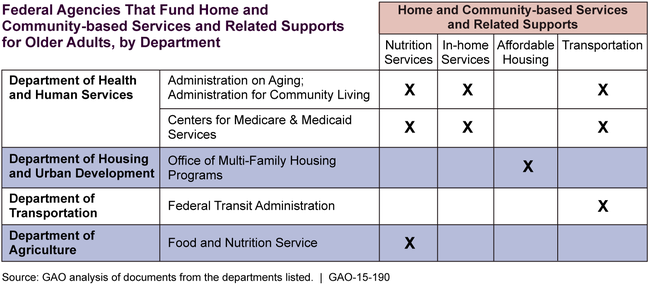Older Adults: Federal Strategy Needed to Help Ensure Efficient and Effective Delivery of Home and Community-Based Services and Supports
Highlights
What GAO Found
Five federal agencies within four departments fund home and community-based services and supports that older adults often require to continue living independently in their own homes and communities. The Administration on Aging (AoA) and Centers for Medicare & Medicaid Services (CMS) in the Department of Health and Human Services (HHS), and the Departments of Housing and Urban Development (HUD), Transportation (DOT), and Agriculture (USDA) provide funds, often through state agencies, to local governments and community-based organizations.

The Older Americans Act of 1965 (the Act) requires AoA to promote and support a comprehensive system of services.
In the three localities GAO visited, local area agencies on aging, assisted by other community-based organizations, took the lead in planning and delivering services and supports for older adults, paid for with a mix of federal, state, and local funding. An Atlanta organization employed home-care aides for older adults and delivered meals. Senior housing developments across the three localities connected more frail residents to in-home services. In San Francisco and Montgomery County, grassroots organizations known as villages provided help with errands. Officials in two localities reported that flat funding of certain state funds, combined with the growing number of older adults, has resulted in waiting lists for affordable housing and in-home services.
The Act requires AoA to facilitate collaboration among federal agencies; however, the five agencies that fund these services and supports for older adults do so, for the most part, independently. GAO's work on interagency collaboration has found that collaboration is important for federal efforts that involve more than one agency. HHS, through AoA, has indicated that competing priorities for its limited resources prevent it from leading development of a cross-agency federal strategy. However, developing such a strategy could help ensure that the five agencies' resources for HCBS and supports are used efficiently and effectively.
Why GAO Did This Study
Research has shown that many older adults want to age in their homes and communities, and their ability to do so often depends on the availability of home and community-based services and other supports. GAO was asked to review the availability of such services.
This report addresses (1) federal programs that fund these services and supports for older adults, (2) how these services and supports are planned and delivered in selected localities, and (3) agencies' efforts to promote a coordinated federal system of these services and supports. GAO reviewed federal program documents and interviewed federal officials. It also visited programs in the Atlanta, Georgia region, Montgomery County, Maryland, and San Francisco California, chosen based on efforts made to enhance their system of HCBS and supports, recommendations from federal agencies and experts, varied governmental jurisdiction, and geographic dispersion.
Recommendations
GAO recommends that HHS facilitate development of a cross agency federal strategy to ensure efficient and effective use of federal resources for HCBS. HHS concurred and HUD, DOT, and USDA did not comment.
Recommendations for Executive Action
| Agency Affected | Recommendation | Status |
|---|---|---|
| Department of Health and Human Services | The Secretary of the Department of Health and Human Services should facilitate development of a cross-agency federal strategy to help ensure that federal resources from Administration for Community Living, CMS, USDA, HUD, and DOT are effectively and efficiently used to support a comprehensive system of HCBS and related supports for older adults. Through such a strategy the agencies could, for example, define common outcomes for affordable housing with supportive services, non-medical transportation, and nutrition assistance at the federal level; develop lessons learned for the local networks that area agencies on aging and community-based organizations are forming; and develop strategies for leveraging limited resources. |
HHS agreed with this recommendation, noting that it continually strives to improve its strategic coordination and described ways that it facilitates cross agency strategic efforts. HHS has addressed this recommendation through its various interagency efforts over the years examining the HCBS needs of older adults. For instance, in 2015, HHS described HHS and HUD collaboration on policy research projects concerning housing and supportive services for older adults, including a comparison of health service utilization by older adults who live in assisted housing with those who do not and an evaluation of a demonstration in Vermont that provides services and supports to residents of HUD-assisted housing. In 2017, HHS described efforts between ACL, CMS, and DOT's Coordinating Council on Access and Mobility to address in-home services, transportation, and other needs of older adults. Additionally, in 2018, ACL participated in a daylong workshop with CMS, HUD, USDA, DOT and other federal agencies examining housing and health needs for rural older adults and adults with disabilities. The workshop enabled agencies to share information on cross-cutting issues and identify areas for additional work.
|
